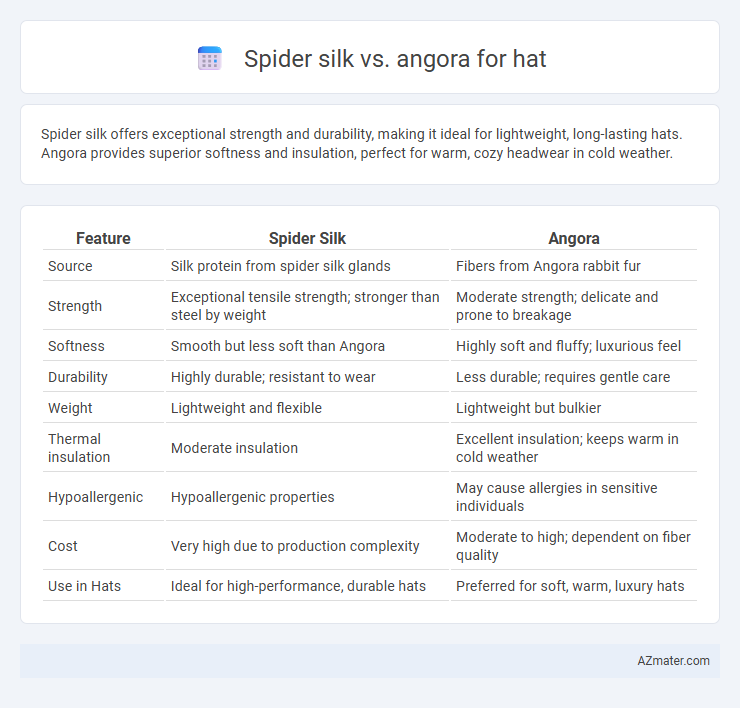Spider silk offers exceptional strength and durability, making it ideal for lightweight, long-lasting hats. Angora provides superior softness and insulation, perfect for warm, cozy headwear in cold weather.
Table of Comparison
| Feature | Spider Silk | Angora |
|---|---|---|
| Source | Silk protein from spider silk glands | Fibers from Angora rabbit fur |
| Strength | Exceptional tensile strength; stronger than steel by weight | Moderate strength; delicate and prone to breakage |
| Softness | Smooth but less soft than Angora | Highly soft and fluffy; luxurious feel |
| Durability | Highly durable; resistant to wear | Less durable; requires gentle care |
| Weight | Lightweight and flexible | Lightweight but bulkier |
| Thermal insulation | Moderate insulation | Excellent insulation; keeps warm in cold weather |
| Hypoallergenic | Hypoallergenic properties | May cause allergies in sensitive individuals |
| Cost | Very high due to production complexity | Moderate to high; dependent on fiber quality |
| Use in Hats | Ideal for high-performance, durable hats | Preferred for soft, warm, luxury hats |
Introduction: Spider Silk and Angora Overview
Spider silk, renowned for its exceptional tensile strength and lightweight properties, offers unmatched durability and flexibility ideal for hat materials. Angora, derived from the Angora rabbit, is prized for its softness, warmth, and luxurious texture, making it a popular choice for comfort and insulation in hats. Comparing these fibers highlights spider silk's superior strength and moisture resistance against Angora's plush warmth and natural insulation qualities.
Origin and Production Methods
Spider silk, primarily harvested through biotechnological synthesis involving genetically modified organisms, originates from spider fibroin proteins known for exceptional tensile strength and elasticity. Angora wool, derived from the Angora rabbit, is collected by a meticulous process of hand-combing or shearing to obtain fine, lightweight fibers prized for softness and insulation. While spider silk production emphasizes advanced bioengineering techniques for scalability, Angora relies on traditional animal husbandry and fiber harvesting methods rooted in centuries-old practices.
Fiber Structure and Composition
Spider silk fibers exhibit a unique protein-based structure primarily composed of fibroin, characterized by a combination of crystalline beta-sheet nanocrystals and amorphous regions that impart exceptional tensile strength and elasticity. Angora fibers, derived from Angora rabbits, consist mainly of keratin protein with a soft, fine, and hollow core structure ensuring superior insulation and lightweight warmth in hats. The distinct molecular arrangements and fiber morphologies directly influence the durability, thermal properties, and tactile comfort of hats made from spider silk versus angora.
Softness and Texture Comparison
Spider silk offers an exceptional softness with a smooth, fine texture that is both lightweight and durable, making it ideal for hats requiring a luxurious yet strong material. Angora, derived from rabbit fur, provides a plush, fluffy softness that feels warm and cozy but is more prone to matting and less resilient than spider silk. The choice between the two depends on whether the priority is a sleek, durable finish or a traditionally soft, insulating feel.
Warmth and Insulation Properties
Spider silk offers exceptional thermal regulation and insulation due to its fine, lightweight fibers that trap heat while remaining breathable. Angora, derived from rabbit fur, provides superior warmth with a soft, dense texture that excels in moisture-wicking and heat retention. Comparing warmth and insulation, angora delivers more effective cold protection, whereas spider silk enhances comfort through its unique combination of warmth and breathability.
Durability and Longevity
Spider silk boasts exceptional durability and longevity, surpassing many natural fibers, including Angora, due to its unique protein structure that provides high tensile strength and resistance to wear. In comparison, Angora, sourced from Angora rabbits, offers softness and warmth but tends to be more delicate and prone to pilling and damage over time. For hats requiring long-lasting resilience and minimal maintenance, spider silk presents a superior option, while Angora suits styles prioritizing comfort and luxury over durability.
Weight and Breathability in Hats
Spider silk offers exceptional lightweight properties and superior breathability compared to traditional materials, making hats made from spider silk extremely comfortable for extended wear. Angora, while soft and warm, is heavier and less breathable, which can lead to increased heat retention and moisture buildup inside the hat. For performance-focused headwear, spider silk's enhanced ventilation and minimal weight provide a distinct advantage over angora fabrics.
Allergenicity and Skin Sensitivity
Spider silk offers hypoallergenic properties, making it ideal for individuals with sensitive skin or allergies, as it lacks common irritants found in natural fibers. Angora, derived from rabbit fur, contains lanolin and can provoke allergic reactions or skin irritation in sensitive wearers. Choosing spider silk for hats minimizes allergenicity and enhances comfort for those prone to skin sensitivity.
Sustainability and Environmental Impact
Spider silk offers exceptional sustainability due to its biodegradable nature and minimal environmental footprint in production, as it requires no harmful chemicals or intensive water use. Angora wool raises environmental concerns linked to animal welfare and habitat disruption, with ethical sourcing being crucial to minimize its impact. Choosing spider silk over Angora for hat manufacturing significantly reduces ecological strain and supports environmentally responsible fashion practices.
Cost and Accessibility for Consumers
Spider silk hats command a premium price due to complex harvesting and limited production, making them less accessible for average consumers. Angora hats offer a more affordable alternative with greater availability thanks to established farming and widely available Angora wool. Cost-effective sourcing and broader distribution render Angora a practical choice for budget-conscious hat buyers.

Infographic: Spider silk vs Angora for Hat
 azmater.com
azmater.com